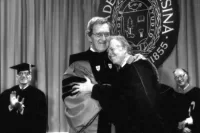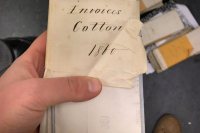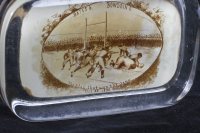
Scene Again: Classroom in the Sky
In 1940, the Civilian Pilot Training Program put Bates students in the air

Catherine Winne '41 poses in front of a Piper Cub in November 1940. Winne is believed to be the only Bates woman who learned to fly through the Civilian Pilot Training Program. Photograph courtesy of the Muskie Archives and Special Collections Library.
From high in the sky, Maine looks like “a land of lakes, all within a stone’s throw of each other,” wrote Catherine Winne ’41 in the Oct. 30, 1940, issue of The Bates Student following her pilot training flight.
Winne is believed to be the only Bates woman who learned to fly through the government-sponsored Civilian Pilot Training Program. She’s seen here in November 1940 standing in front of the program’s training plane, a two-seat Piper Cub, at what is now the Auburn-Lewiston Municipal Airport.
“We knew it was a pre-screening thing for military pilots.”
Begun in 1938 to increase the number of civilian U.S. pilots, the CPTP gave flight training to hundreds of thousands of men and women, mostly college students. The program is specifically credited with creating a path for African Americans to eventually become military pilots, notably the Tuskegee Airmen. Bates, Bowdoin, Colby, and UMaine offered chapters in Maine, as did several high schools and American Legion chapters.
Women were given 10 percent of the slots, which meant two spots among 20 at Bates, though they were excluded after the U.S. joined World War II. Winne, who died in 2007, was one female Bates trainee; the late Pauline Giles ’41 attended classroom sessions but it is unclear if she ever flew.
The CPTP’s military importance was readily known, especially after Germany invaded Poland and France. “We knew it was a pre-screening thing for military pilots,” says retired Marine Col. Armand Daddazio ’42, who was a CPTP trainee as a Bates student. After graduating, Daddazio saw active duty in air defense artillery in the Pacific.
He was on Tinian when the USS Indianapolis delivered the atomic bomb destined for Hiroshima. “Headquarters called to ask for officers for a work party,” Daddazio recalls. “We pointed out that officers don’t go on work parties. The reply was, ‘Well, they do on this one!’ For security, they wanted officers to unload the bomb.”
Now living in El Paso, Texas, after a career in financial services, Daddazio did not fly during or after the war. Initially interested in the Army Air Corps, he instead chose the Marines. “The casualty rate ended up pretty bad for the flying services,” he recalls. “Maybe the dear Lord didn’t want me to fly.” — HJB




